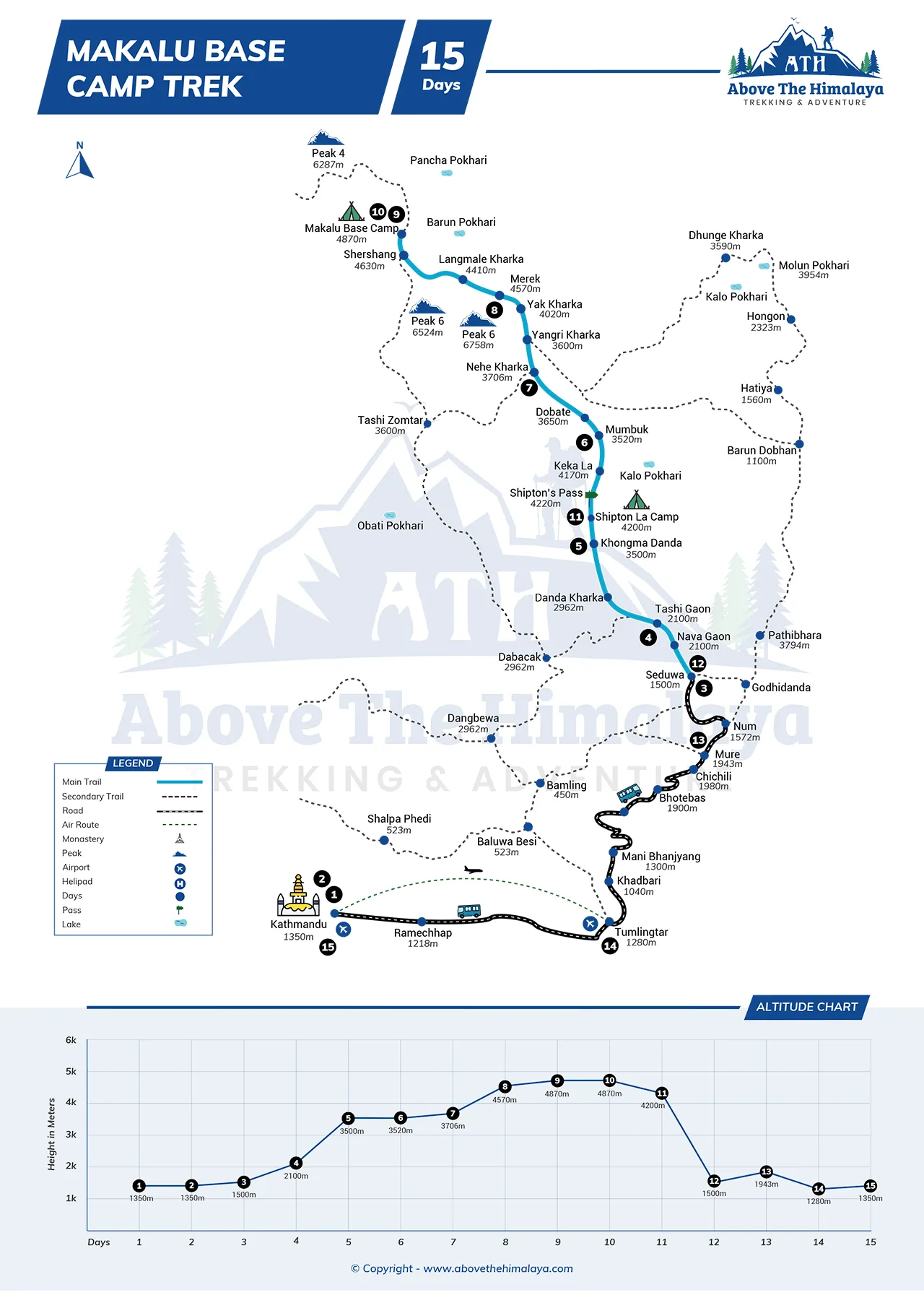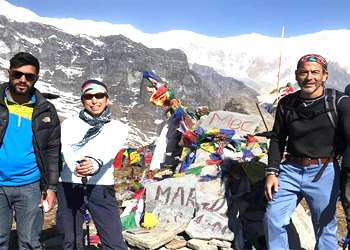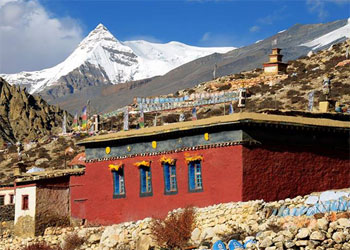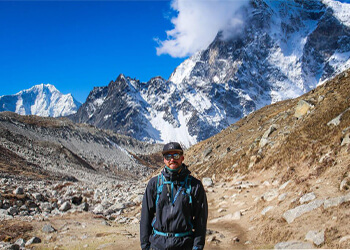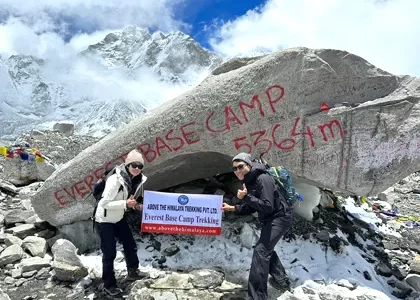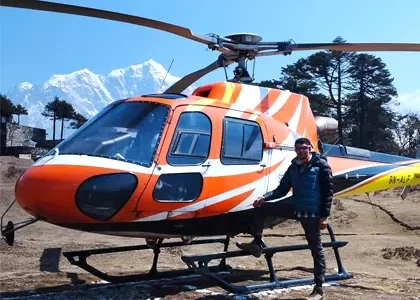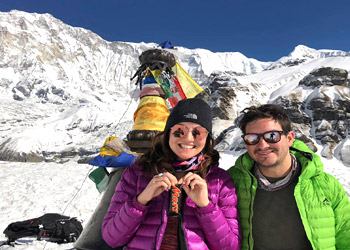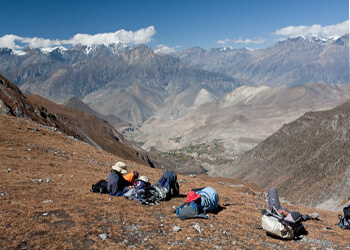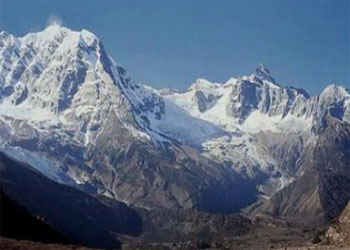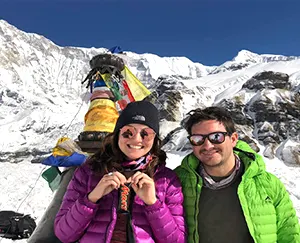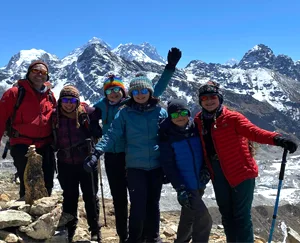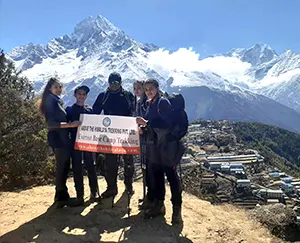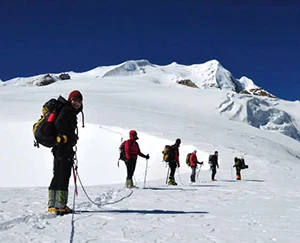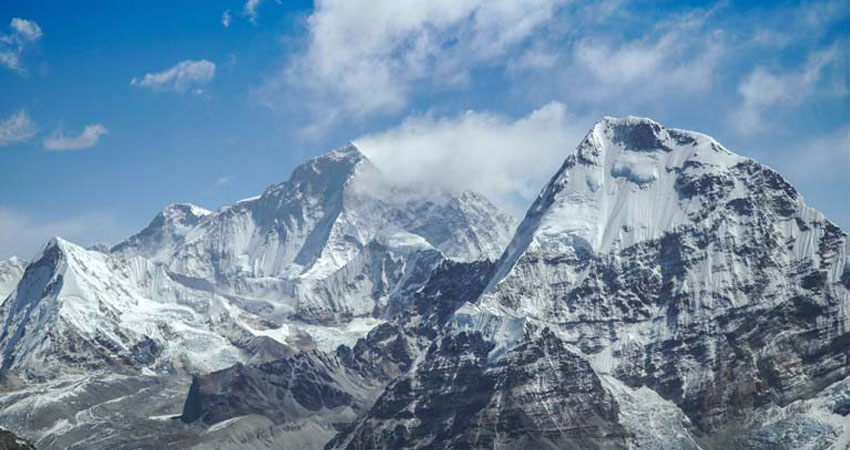
Makalu Base camp Trek Highlights
- View the fifth-highest mountain Mount Makalu as well as Everest and Lhotse and Kanchenjunga which stand beside it.
- Witness rare wildlife such as the red panda, snow leopard, and Himalayan tahr in Makalu Barun National Park.
- Step into the Rai and Sherpa way of life in rural villages such as Seduwa, Mumbuk and Tashigaon.
- Trek through forested areas followed by terraced farms and advancing into alpine meadows before entering harsh high-altitude territories.
- Work towards conquering Shipton La Pass at 4,210 meters which brings adventurous joy.
- Exposure to local customs of the Rai and Sherpa people in numerous cultural villages.
- View magnificent Makalu and additional peaks from Makalu Base Camp at 4,870 meters.
- Enjoy solitude together with serenity at this trail because it receives less foot traffic than other well-known trekking paths.
Overview of Makalu Base Camp Trek
The Makalu Base Camp Trek leads travelers to an untouched trekking destination within Nepal. The trek leads hikers to Mount Makalu base (8,481m) while presenting wide views that combine Makalu alongside Everest, Lhotse and Baruntse.
The path traverses through multiple environmental zones of Makalu Barun National Park starting from dense forests before leading along terraced farmland and glacier river valleys and concluding in elevated mountain topography.
The remote Makalu Base Camp area presents itself as a less touristic alternative than Everest or Annapurna regions because it enables tourists to encounter original Himalayan lifestyles and pure untouched mountains.
The adventure begins with taking a flight to Tumlingtar which leads travelers into traversing Shipton La Pass (4,250m) along with Mumbuk’s rhododendron forests and ending up in the Barun glacial valley.
Trekkers get to see a wide range of ecosystems which include the tropical forests at the bottom then transition to icy moraines that are near base camp. Naturalists exploring the route can spot three Himalayan creatures including red pandas along with snow leopards and blue sheep.
Those who want genuine Himalayan exploration together with cultural exploration and altitude challenges will find the perfect combination in this trek.
The lack of crowds and deep immersion into the land make the Makalu Base Camp Trek stand as Nepal’s concealed Himalayan gem.
Why Makalu Base Camp Trek?
Tourists can experience the most unique trekking adventure within Nepal’s least explored distant mountain region through the Makalu Base Camp Trek. Along the trek, the route offers an alternative to popular trails like Annapurna and Everest because it guides travelers through unspoiled landscapes across forests and valleys where people encounter few other visitors.
The peak moment of this trek leads hikers to Makalu Base Camp (4,870m) for a direct view of the magnificent fifth-highest peak, Makalu. This trek provides everything wilderness enthusiasts dream about and more.
You will explore various geographic features that include tropical forests and alpine meadows along with glacial terrains while meeting unique Himalayan creatures including red pandas and Himalayan black bears as well as snow leopards.
Together with the Shipton La Pass (4,250m) you will experience among the best mountain panoramas that Nepal has to offer.
The Makalu Base Camp trek stands out because of the remarkable cultural encounters it provides to travelers. During the trek, participants can observe local practices as well as traditional ways of life of Rai, Sherpa and Tibetan communities who dwell in distant small communities.
Makalu Base Camp suits seasoned hikers who prefer to do wild Himalayan trips that offer both tough challenges and wholesome experiences.
Itinerary of Makalu Base Camp Trek
01
Day 01: Arrival at Kathmandu and transfer to hotel
Travelers will find welcome at Tribhuvan International Airport in Kathmandu where a representative provides reception before hotel accommodation in the city. Kathmandu functions as the capital of Nepal while remaining a cultural center and historic quarter that features historic places of worship together with busy district markets.
Hotel guests will find time to relax and regain their energy after hotel check-in. You can explore the busy Tourist district of Thamel where you will find trekking shops and authentic eateries along with its lively environment if time allows.
A pre-trek briefing provided by your guide will deliver necessary information about the trek along with safety protocols and specific itinerary descriptions at the night meeting.
02
Day 02: Preparation Day and Sightseeing in Kathmandu
Day two combines trekking supply organization with sightseeing activities throughout Kathmandu city. You need to inspect your trekking equipment and verify all needed permits before buying any extra equipment, if needed, during the morning hours.
The variety of trekking shops throughout Kathmandu provides tourists with easy access to obtain any required trekking equipment. Your day also brings together sightseeing to visit Kathmandu’s historical sites after completing your necessary preparations.
During the sightseeing tour of Kathmandu people will see Pashupatinath Temple as the sacred Hindu Shiva shrine followed by Swayambhunath Stupa known as the Monkey Temple and Boudhanath Stupa which is the vast Buddhist site respected by Tibetan Buddhists.
Along with your visit, you will see Kathmandu Durbar Square which displays ancient Nepalese architecture and intricate wood carvings inside royal palace historical courtyards. Hotel accommodations on this day will enable you to finish packing while relaxing before starting your early departure the next morning.
03
Day 03: Fly to Tumlingtar and Drive to Seduwa
The actual exploration of Makalu Base Camp commences on the third day of the expedition. Traveling by domestic aircraft in the early morning you will reach Tumlingtar through the small Nepalese town situated in eastern Nepal.
A marvelous 50-minute flight showcases spectacular Himalayan peaks that extend in majestic rows as they rise with snowy tops across the view. After landing in Tumlingtar, you will access a local jeep which takes you to Seduwa where the trek officially begins.
The transit from Tumlingtar to Seduwa lasts four to five hours while showing viewers traditional Nepali rural scenery that includes green hills and mountain terraced fields and small towns. The Makalu region deepens until dense forests appear next to rising elevation conditions.
When arriving at Seduwa your permits will be checked before permission is granted to continue. The visit to Seduwa ends with hotel check-in at a local teahouse or lodge that lets you experience the tranquil atmosphere. One stops motor transportation at this point which precedes walking along the trail.
04
Day 04: Trek from Sedua to Tashigaon
The first phase of your Makalu base camp trek becomes active on this fourth day. Your day begins as you eat breakfast before you start walking from Seduwa through forests and farmlands and villages of the local communities.
The trail grants wide perspectives of the surrounding hills and valleys as you catch occasional views of peaks with snow-covered tops in the distance. The trek has an intermediate level of difficulty since it contains both secure uphill sections and easy flat stretches.
Residents in these settlements cultivate millet, barley and potatoes on the fields as you travel past their villages. Walking through this trail leads you through rhododendron forests during April, when their flowering season creates a spectacular display.
You will reach Tashigaon, which stands as the final substantial settlement preceding the isolated high-altitude region,n after spending five hours on your trek. You will stay at the teahouse while having dinner then prepare yourself for the demanding climb ahead during the following days.
05
Day 05: Trek from Tashigaon to Khongma
Before the daunting ascent from Tashigaon begins you will have a satisfying breakfast at the locality. The path leads gradually uphill while passing through thickets of oak and rhododendron which allows brief wildlife sightings of Himalayan monals and langurs.
Moving upward into the altitude brings about a gradual fade of the forested landscape until the path steepens to demand focused physical work.
The trek demands multiple steep stone staircases along with switchbacks which produces a physical difficulty scaling across this region. Continuing to climb higher altitudes leads to lower oxygen levels while the atmospheric density tracks down until it becomes obvious.
Because of its elevation, the environment evolves from forested lands into high-elevation grasslands and stone-covered ground, which gives excellent perspectives of the distant mountain peaks.
The six-hour to seven-hour trail leads trekking groups to Khongma which rests in the mountains as a small stopping point. The elevated position at this location makes temperatures extremely low so proper layering becomes essential to stay warm during nighttime.
A basic teahouse accommodation combined with a nourishing evening meal allows you to recuperate before the challenging high-altitude portions ahead.
06
Day 06: Trek from Khongma to Mumbuk
From Khongma you will progress upward to Khongma La Pass while crossing multiple high mountain passes. You will face two challenges during day six since the expedition demands passing through Shipton La (4,250m), Keke La (4,170m), and Tutu La (4,120m).
The exceptional mountain view panorama of Makalu, along with Chamlang and Baruntse peaks, becomes a rewarding outcome of your strenuous effort throughout each pass.
The trail descends rapidly from all those passes leading directly toward Mumbuk. The trail transitions from rocky surfaces to a forested landscape which creates a pleasant diversion in scenery.
You will spot increased bush growth while walking downhill because tall pine trees, together with fir trees, will guide your path. Caution needs to be maintained during the descent because the rocks are loose.
You will need six to seven hours for the trek to Mumbuk where you can find peace in this forested campsite to spend the night. Mumbuk remains the perfect area for recuperation because its forested setting pairs well with its natural backdrop.
07
Day 07: Terk to Nehe Kharka from Mumbuk
Your day starts with a forest descent at Mumbuk, where you follow an uneven trail that runs along the slope of the Barun River toward lower heights.
The verge of Mumbuk and Nehe Kharka hides underneath the continuous noise of flowing water, while wooden bridges and stone paths lead to your destination. The path exists among immense cliff formations with newly formed waterfalls that enhance the dramatic natural beauty.
A long stretch of Nehe Kharka appears before you as you advance into the wide open grassy region. From its position at 3,660 meters elevation, Nehe Kharka shows itself as a breathtaking area that combines stunning vistas of snow-covered peaks with yak-grazed pastures all around.
Traversing from Nehe Kharka requires a hike of six to seven hours despite minimal elevation gains since the altitude poses significant difficulties for travelers.
The first stop will determine whether you stay at a teahouse accommodation or use camping facilities based on your chosen arrangements. The peaceful environment will be dedicated to rest and preparation for further exploration within the secluded Makalu territory.
08
Day 08: Trek to Merek from Nehe Kharka
Today’s trek guides you deeper into Makalu Barun National Park when you travel to Merek. The path along the Barun River leads through an ascent that reveals majestic cliffs together with glacial ice formations.
From this point onward, the environment grows more arid because there are diminishing forested areas, but only rocky plateaus and elevated alpine regions remain.
Rising elevation transforms the surroundings while exposing you to distinct symptoms of high altitude clearance. The way to success requires a controlled tempo in addition to plenty of water and absolute attention to your physical signals.
The way through glacial moraines leads hikers past several scattered boulders while showcasing stunning mountain vistas along the trek.
Walking for five to six hours will lead you to Merek which sits at 4,570 meters above sea level as a small settlement. When looking up at the skyline you will find nothing but the stunning views of peaks including Makalu and its closest neighbors.
The steep altitude makes Merek experience freezing night temperatures demanding the use of warm clothing and restful sleep. Basic teahouse accommodation awaits you for the night which features both a delicious food offering alongside breathtaking views of the mountains.
09
Day 09: Trek to Makalu Base Camp from Merek
The route to Makalu Base Camp starts right after Merek serves you an early breakfast. Your path leads you through barren terrain which slowly turns hostile while climbing up the glacial moraines with rocky pathways. Traversing high-altitude locations becomes harder because of the scarce air pressure thus hikers need to walk at a controlled speed.
During your forward progress, visitors will encounter breathtaking landscape sights. Mount Makalu (8,481m) rises as a powerful mass from the skyline while its neighbor peaks Everest, Lhotse, and Baruntse appear in the distance.
The path guides you through cold rushing streams among glacial materials while it creates a spectacular dichotomy between the snowy peaks and the exposed mountains below.
The destination of Makalu Base Camp will become visible after a five to six-hour trek at an elevation of 4,870 meters. People visiting Makalu Base Camp have the chance to see the enormous South Face of Makalu because it stands among the world’s 8,000-meter peaks that have received the least amount of climbing attempts.
The empty but impressive landscape creates an authentic feeling about the disconnected nature of this journey. The simple teahouse accommodation or tent facilities at the campsite will provide you with a meal alongside breathtaking Himalayas views during your overnight stay.
10
Day 10: Exploration Day at Makalu Base Camp
Makalu Base Camp visitors today fully immerse themselves in the spectacular natural environment. The time at Makalu Base Camp allows attraction to breathtaking scenery as well as adaptation before the return trek begins.
The primary attraction of this day is a brief hike that leads visitors to superior outlooks around the base camp area for viewing Makalu alongside Everest and Lhotse peaks and the Barun Glacier. A visit to the 5,300-meter-high upper viewpoint delivers exceptional views of Mount Makalu and shapes and peaks located nearby.
Spending time at the enormous Barun Glacier is a must because this giant ice mass descends from the slopes of Makalu. The wildlife here possesses unusual species like blue sheep, together with Himalayan marmot,s and the very rare snow leopard may show itself if the circumstances are right.
Consume the day by relaxing at the peaceful Himalayas. Given the elevational height, it is vital to maintain hydration and exercise restraint with physical effort. You will spend another night at the base camp, where you can fully appreciate your position within Nepal’s most distant regions.
11
Day 11: Trek from Makalu Base Camp to Nehe Kharka, then to Shipton La Camp
The first meal of the day starts as you leave Makalu Base Camp to start your trail back towards Nehe Kharka. The returning path presents opposite views of the glacial landscape while shifting light conditions expose fresh features of the glaciers and mountain peaks.
You will return to Nehe Kharka and Shipton La Camp by walking your previous trail down through Merek and continuing along the Barun River valley. Although descending presents less difficulty than ascending the path, it remains physically demanding because of the long walking hours across rocky surfaces and uneven ground.
The Nehe Kharka stop will last a brief moment before beginning your climb to Shipton La Camp. The climb beyond this point demands additional effort as it crosses mountain plains while passing through breathtaking scenery before reaching the high-elevation passes.
The total trekking duration of approximately seven to eight hours will lead you to Shipton La Camp situated near the Shipton La Pass (4,250m). You will rest at this location while watching magnificent peak views in the distance before finally sleeping.
12
Day 12: Trek to Dobato and then to Seduwa
The first half of this day involves moving toward Dobato which exists as a tiny settlement positioned on the descending trail. From Shipton La, you will trek downhill through paths that lead to rocky terrains dominated by rhododendron forests until you descend to lower elevations.
A dramatic change in atmosphere occurs as altitude drops because green meadows and dense pine woodlands appear alongside the path. Thankfully the increased amount of oxygen in the air simplifies breathing which has become more difficult during recent days.
From Dobato you will descend to Seduwa while passing classical villages and seeing the beautiful terraced crop fields. The hike will expose you to local communities made up mostly of Rai and Sherpa ethnic populations. Meeting the local residents gives you an excellent chance to discover their traditional lifestyle.
The total hike from Seduwa requires six to seven hours. Upon completion of your journey into unexplored areas of the Makalu region, you will find shelter at a teahouse and recharge while eating dinner followed by thoughtful consideration of your touteous exploration.
13
Day 13: Trek to Mure from Seduwa
The path between Seduwa and Mure involves crossing numerous green hills while passing initialized agricultural lands and several small traditional settlements. The descending terrain of this trail makes the walking experience less demanding than what you experienced throughout the earlier days.
You will observe a change in vegetation as forests combine with cultivated areas. Traveling from Mure to Seduwa requires six hours of walking time to appreciate breathtaking valley views during the trip. You will reach Mure located in the hills where you can spend your night at a teahouse while remembering all your trekking adventures and eating a warm meal.
14
Day 14: Trek to Tumlinhtar from Mure
You begin the conclusion of your trek by leaving Mure to continue to Tumlingtar. From this point onward the descent continues while you pass through areas with stunning landscapes that contain numerous small villages combined with farm terraces.
You will encounter streams and pass through subtropical woods on your path while experiencing the milder temperatures that appear with descending elevations.
The route to Tumlingtar takes a total of five to six hours before you can settle into accommodations at the lodge set in the trekking terrain. Makalu Base Camp adventure reaches its successful end as you have the perfect celebration opportunity.
15
Day 15: Drive to Kathmandu from Tumlingtar
The last day Makalu base camp trek concludes with an early morning domestic flight connecting Tumlingtar to Kathmandu. The brief flight enables spectators to enjoy one more spectacular Himalayan mountain view while finishing their trekking adventure.
After arriving in Kathmandu through your flight you will obtain hotel transportation to your accommodation for relaxation. The time available permits you to either travel around the city while seeking souvenirs or enjoy a rest at one of the local eateries. After completing the incredible trek, you should plan a celebration dinner that takes place in the evening.
Trip Extension
Suppose you have more time in Nepal after this trip. In that case, we can help you to extend your trip by running different treks in Nepal, tours in Bhutan and Tibet, Jungle safari tours at Chitwan, Bardia, and other National parks, Nepal luxury hotel booking, Rafting, Ultra-light flights, or any other travel-related services. You can get more information here.
Includes/Excludes
What's Included?
- Airport / Hotel / Airport transfers by private vehicle.
- Hotel Accommodation in Kathmandu, including breakfast.
- Guided Tour of Kathmandu City with expert tour guide and private vehicle
- Government license holder experienced, trekking guide (trained in Wilderness First Aid& altitude sickness) and porters (1 porter for between 2 trekkers basis) with their food, accommodation, salary, equipment, accidental insurance, clothing, and medicine.
- Round Trip flight ticket for Kathmandu Tumlingtar Kathmandu.
- All meals during trekking are 3 meals daily (Breakfasts, lunches, dinners, etc.).
- Special Trekking Permit for Makalu Base Camp.
- Trekker’s information management system (TIMS) card.
- Group medical supplies (first aid kit will be available).
- Above the Himalayan duffel bag. ( If you need to, please let us know before you book the trip and remind us in our pre-meeting at our office)
- Comprehensive pre-departure information and trip dossiers
- Above the Himalaya Gifts (T-shirt for Gents & Pashmina shawl for Ladies, Trekking certificates)
- Welcome/Fare well Nepali Dinner in Kathmandu
- All necessary papers, office Service charges, and all Government Taxes
What's Excluded?
- Lunch and dinner in Kathmandu.
- Nepal entry visa fee: you can get a Nepal visa upon arrival at the Airport.
- International Airfare/Airport tax, City tour Sightseeing entry fees.
- Alcoholic, hot and cold drinks, hot water, hot and cold showers.
- Personal expenses include laundry, telephone calls, sweets, snacks, beverages, bar bills, and camera battery charging.
- Travel Insurance (Essential – Should include emergency evacuation coverage while trekking up to 5500+ meters).
- Personal trekking gears
- Tips for tour/ trekking staff and driver
- Any other expenses that are not mentioned in the Price Includes section.
Route Map & Altitude Chart
Who can do the Makalu Base Camp Trek?
The Makalu Base Camp Trek proves challenging and best for professional hikers and people with solid physical aptitude. Hiking to Makalu Base Camp becomes significantly harder due to the intense elevation climbs and rough paths along with various mountain passes which exceed the difficulties of exploring Everest Base Camp.
The trek requires no more than standard high-altitude trekking experience (more than 4,000m in elevation). Newcomers who plan their preparations well along with determined focus toward the goal will successfully finish this trek after proper acclimatization and sufficient training.
Successful completion of the trek requires excellent fitness because you will walk 6 to 7 hours per day across 16 to 19 days. Physical training prior to this trek must include cardiovascular endurance together with leg strength and stamina-building exercises through hiking, running and cycling.
People who enjoy nature and adventure sports along with photography will find the perfect combination at this trek since it provides untouched landscape beauty and various wildlife species and breathtaking mountain views.
Travelers need mental readiness to accept minimal facilities, together with sharp weather variations besides isolated environmental situations.
Best Time for Makalu Base Camp Trek
The Makalu Base Camp Trek should be conducted in the spring months from March to May or in the autumn months from September to November. Stable climatic conditions exist in the spring and autumn months which generate optimal trekking conditions while providing clear views of the scenery.
The trail becomes spectacular because of rhododendron blossoms in spring (March to May) while moderate weather creates perfect trekking conditions. The clarity of views from Makalu to Everest to Lhotse allows open visibility while red pandas and Himalayan monals become more frequently spotted in this region.
The autumn months from September to November create an ideal period when stable weather patterns emerge following the monsoon conditions.
During this season the hiking paths maintain their leafy freshness while presenting breathtaking views of mountain summits in white snow. Mountain trekking experiences maximum comfort during this season because of the pleasant temperature along with the fresh clean mountain air.
Makalu Base Camp Trek during Winter
The winter season between December to February presents a remarkable set of difficult conditions to Makalu Base Camp trekkers because of harsh wind conditions plus extreme cold temperatures and significant snowfall. The region around Shipton La Pass and Mumbuk develops into a dangerous trail because heavy snowfall blankets its surfaces.
The winter climate presents dangerous conditions to trekking groups because temperatures drop below -20°C and visibility allows visitors to see Makalu Everest and Baruntse mountains in clear skies.
Most teahouses above a certain altitude do not operate in the winter months so hikers must transport their own camping supplies with them. Traveling to Makalu Base Camp becomes dangerous because it heightens the risk factors associated with altitude sickness alongside frostbite and avalanches.
The Makalu base camp trek becomes feasible for experienced mountaineers using proper winter gear as well as professional guides while implementing safety protocols. During the winter months, the trek presents a special experience because few travelers explore the pristine wilderness.
Anyone planning to visit Makalu Base Camp in winter needs to exercise caution while maintaining physical aptitude and must prepare properly before beginning the trip. Before attempting this risky hike, trekkers should check weather reports while also having emergency evacuations prepared and proper additional insulation to use.
Is Makalu Trekking in Monsoon Possible?
Makalu Base Camp Trek during the monsoon period (June to August) presents difficulty due to challenging conditions which make the trek advisable only to experienced travelers.
Heavy monsoon rainfall turns the trekking paths into dangerous conditions with slippery surfaces and landslides and water-logged terrain. The rising rivers present dangerous challenges for crossing while poor visibility occurs due to thick clouds and fog.
Lower elevation areas are infested with leeches as well as mosquitoes which lead to unpleasant trekking conditions. Professional trekkers who take adequate preparation can find positive experiences in monsoon trail travels.
The landscape becomes immensely attractive because of its abundant greenery together with blooming flowers and dramatic waterfalls. A minimal presence of visitors enables visitors to feel isolated on their trek.
Affirmative monsoon trekking requires appropriate rain protection along with water-resistant backpacks along with solid trekking boots.
Getting a local guide to accompany you during your trek is strongly advised because they master the challenging terrain and provide protection. The correct readiness combined with determination allows people to finish the journey even when facing unpredictable weather conditions.
Weather Conditions During Makalu Base Camp Trek
The climate conditions in Makalu differ substantially according to both altitude levels and seasonal periods. Extended areas of the trek maintain average temperatures but the cold reaches its worst point in the proximity of Makalu Base Camp (4,870m).
The spring months of March through May give visitors enjoyable temperatures between 5°C and 15°C while rhododendrons bloom in brilliant colors under clear blue skies. The period represents an excellent timeframe to enjoy trekking activities.
During Autumn (September to November) the trekking conditions remain optimal due to temperatures between 0°C to 10°C and stable weather conditions and clear visibility.
During Winter (December through February) the upper parts of the trek face brutally cold temperatures between -10°C and -25°C in combination with heavy snow accumulation and powerful winds leading to dangerous conditions.
During the monsoon season (June to August) the terrain becomes slippery with heavy rains and landslides and trail paths become difficult to traverse because of the leech population.
Large changes in temperature and unforeseen conditions at elevated heights become risk factors for trekking so trekkers should consult weather reports prior to their trek. A trekker needs suitable layering of clothes and waterproof outerwear together with superior trekking equipment to survive different weather patterns.
Permits Required to Makalu Base Cam Trekking
Two permits are necessary for anyone wanting to trek to the Makalu Base Camp.
Firstly, travellers must obtain Makalu Barun National Park, which is home to wildlife biodiversity. A foreign trekker must pay NPR 3,000 whereas SAARC nationals must pay NPR 1,500 to acquire this permit.
Trekking in the Makalu region requires the Makalu Rural Municipality Permit which costs each individual NPR 2,000.
Unlike Annapurna or Everest treks, the Makalu region lacks the requirement of a TIMS (Trekkers’ Information Management System) card. Trekkers generally let their agency handle permit acquisition to prevent difficulties, while options to buy them exist at Kathmandu and Tumlingtar.
Physical copies of entry permits need to be carried at all times as checkpoint officials strictly enforce checks at Seduwa and other entry points. The necessary permits for accessing Makalu Base Camp are essential because they provide a secure experience in this untouristed wilderness area.
Plants and Animals in the Region
The Makalu Barun National Park maintains 1,500 square kilometers of land as one of the most biodiverse regions in Nepal. Dense vegetation made up of rhododendron oak and pine forests creates colorful displays when spring arrives in the Makalu Base Camp trek’s lower regions.
Because trekkers generally move upward, the area transforms from alpine meadows through juniper shrubs to glacial moraines that establish a striking visual divide between moist vegetation and stark rocks. The area contains both medicinal plants and rare Himalayan herbs that local people use to prepare their traditional medicine.
Immigrants residing in the national park obtain their food and shelter among numerous Himalayan rarest species living inside this protected area. Snow leopards together with red pandas, Himalayan black bears and blue sheep occupy the high-altitude areas where trekkers can catch a glimpse of them.
Birdwatchers who come to the valley can observe Himalayan monals (Nepal’s national bird) with blood pheasants along with golden eagles flying high above them. Musk deer and mountain foxes, together with langurs, choose the forests as their habitat.
Wildlife represents an unspoiled form in the Makalu region because of its remote location which makes this trek ideal for wildlife observers. Everyone who wishes to photograph or observe this exceptional Himalayan environment should bring both binoculars and a camera for their trip.
Packing Essentials for Makalu Base Camp Trek
A successful Makalu Base Camp trek requires correct equipment selection because the route passes through diverse weather conditions and demanding paths.
Choose multiple layers of clothing since they help protect you from varying temperatures. Makalu base camp trekkers need to bring thermal base layers along with fleece jackets and insulated down jackets as well as waterproof shells for protection from rain and snow conditions.
Trekking pants of high quality combined with moisture-wicking shirts need to be packed with gloves and a warm hat together with a buff for wind resistance.
Trekking boots with both water-proof fabric and ankle support become an absolute necessity because the paths contain rocky terrain alongside slippery and river-crossing elements. The feet stay warm throughout higher elevations with woolen socks but light camp shoes or slippers make teahouse visits more comfortable.
Travelers must have a sleeping bag with a rating of -10°C to -20°C to survive the nighttime’s cool weather in the region.
One must also bring trekking poles to stay stable and a headlamp with reserve batteries as well as sunglasses with sunscreen for sun protection and water bottles that contain water purification tablets to keep drinking water safe.
The first-aid kit requires specific components to treat altitude illness along with painkillers as well as bandages. A sufficient supply of dry foods and energy-rich snacks along with dried fruits should be carried because the remote Makalu area lacks extensive facilities.
Proper packing methods produce both comfort alongside safety, which enables the Makalu base camp trekking journey efficiency across the rough Himalayan terrain.
Preparation for the Makalu Base Camp Trek
The Makalu Base Camp Trek demands detailed physical and mental readiness because of its distant location and demanding conditions.
Trekkers planning a trip to Makalu Base Camp need to begin their training regimen two to three months ahead of time by performing cardio exercises beside muscle-building workouts and terrace hiking.
Cardio activities particularly running or swimming with cycling provides better endurance whereas weight-based exercises together with squats and lunges develop muscle strength. Trekkers should use simulated altitude training conditions or perform high-altitude hikes since the journey exceeds 5,000 meters in elevation.
Mental resilience is equally important. The total experience of prolonged trekking through difficult terrain needs people to develop supreme determination paired with flexible attitudes. Besides meditation and breathing exercises people should invest time in familiarizing themselves with anticipated challenges on the Makalu base camp trek.
Additionally, packing appropriately is crucial. Important items for trekking include multiple clothing layers which must be combined with durable hiking boots, trekking poles together with a good sleeping bag along with a fully stocked first-aid kit, a water purification system for hydration and layers of protection.
A high-quality backpack combined with easy-to-carry energy bars together with nuts make trekking in long distances more feasible. Funds for permits and insurance coverage and weather reports together with necessary paperwork need to be secured in advance to begin this trip.
Altitude Sickness and Preventive Measures
Altitude sickness poses a major health risk throughout the Makalu Base Camp Trek because the route exceeds 5,000 meters high. Experiencing headaches together with nausea and dizziness and shortness of breath and fatigue are characteristic symptoms of altitude sickness.
The most severe manifestations of this condition cause two fatal conditions, High Altitude Pulmonary Edema (HAPE) and High Altitude Cerebral Edema (HACE).
Accomplishing acclimatization gradually forms the core of sickness prevention since planned rest periods appear in the travel schedule. Drinking 3 to 4 liters of water per day together with abstaining from alcohol and caffeine consumption and eating a high-carbohydrate diet will assist your body in adjusting to the high altitude conditions.
Trekking participants need to increase their height slowly while sleeping at lower altitudes to enable their bodies to adapt. A physician should monitor prescriptions of Acetazolamide (Diamox) that aid in AMS prevention.
The most effective safety measure during altitude illness progression is a quick descent to a lower elevation. Emergency evacuation through helicopters must become available to trekkers alongside the use of oxygen canisters as part of their safety kit.
Safety during trekking depends on correct planning and symptom monitoring alongside strict adherence to protective practices, which lead to a better trekking experience.
Food and Accommodation During the Makalu Base Camp Trek
Food and lodging services on the Makalu Base Camp Trek offer a range between basic teahouses and tented camps that operate in remote zones.
During the trek basic dining establishments called teahouses serve traditional food such as dal bhat with rice and lentils and vegetables along with noodles, soups, Tibetan bread and pancakes.
Guests will find porridge and eggs as well as chapati for breakfast in the tea houses but dinner options include pasta together with fried rice and traditional food from the area. The availability of food diminishes along with increased prices because of transportation difficulties at elevated altitudes.
The standard lodging in the trek consists of simple tea houses with shared bedrooms equipped with two beds and a slim mattress and public dining areas.
The shared toilet facilities do provide hot showers, yet they become unavailable as elevation increases. Those who prefer camping in tents must plan for cooking supplies and hiring porters to manage their camping equipment.
Bringing energy bars together with lightweight snacks during Nepalese treks is recommended because food access remains unpredictable. The remote location demands that hikers adapt their eating habits to local conditions yet they should maintain readiness for minimum basic services.
You need to bring water bottles and purification filters or tablets since buying water in bottles creates expensive plastic waste. Some luxury accommodations provide authentic hospitality and facilities from local people that enhance the Makalu Base Camp trek.
Culture and Traditions
Multiple ethnic groups with Rai as the dominant population along with Sherpa and Shingsawa (Bhote) reside in the Makalu region while maintaining distinct traditional customs.
People from the Rai ethnicity who reside in the lower regions follow a religion that mixes animistic spirituality with ancestor-based rituals. At higher elevations Sherpa communities prevail while practicing Tibetan Buddhism through their presence of monasteries and prayer flags and chortens across the trekking trails.
The Makalu base camp trek includes a standout cultural experience that consists of visiting villages which contain unmodernized practices from local customs and traditions. Guided by Sherpas who excel in mountain climbing activities trekking in Nepal features Sherpa hospitality as its hallmark quality.
While traveling to Tibet during celebratory months visitors can observe Buddhist daily rituals in monasteries and experience local festivals together with listening to folk tales.
Accepting local traditions remains crucial for trekkers who must perform Namaste greetings and wear appropriate clothing coupled with asking permission for any photographic activities near people or sacred sites.
Servicing monastery donation boxes together with sampling traditional Tibetan foods including butter tea and yak cheese helps guests fully embrace Himalayan culture. The study of local cultural elements within the geology allows visitors to intensify their appreciation for Nepal’s meaningful traditions.
Travel Insurance
All travelers to the Makalu Base Camp Trek must secure travel insurance because of the elevation-related safety hazards.
The proper travel insurance policy must include provisions that address emergency evacuations together with medical payments and trip termination costs along with lost or stolen equipment.
Helicopter evacuation stands as the optimal choice for extreme altitude sickness and serious injuries because Makalu Base Camp does not have easy access to healthcare facilities. Standard insurance plans need explicit altitude coverage up to 5,000 meters because most standard policies exclude this type of activity.
Travelers should obtain extra insurance provisions that protect them when unpredictable weather conditions and political instabilities force them to cancel their trips.
An insurance policy can need a record of being under guided trekking supervision to activate benefits so prior policy inspection is necessary. The presence of policy documentation either in digital or physical format provides immediate help whenever assistance becomes necessary.
Investing in an appropriate insurance plan will protect you from spending excessive amounts when having to pay for medical care and evacuation expenses.
Before buying insurance trekkers need to conduct thorough research to select companies that specialize in providing adventure travel insurance. Accidents during treks become manageable when travelers have suitable coverage since it provides them with security when unexpected emergencies occur.
Most Asked Questions by Travellers
Trekkers should choose spring (March to May) or autumn (September to November) since these months provide stable weather and clear skies giving breathtaking views.
Trekking to Makalu Base Camp demands high physical fitness and trekking experience because of its demanding trail with steep slopes and bumpy pathways and elevated elevation.
Reaching Makalu Base Camp at 4,870 meters (16,000 feet) requires proper altitude adaptation to prevent cases of altitude sickness.
To access the Makalu Barun National Park Permit and the Makalu Rural Municipality Permit you can utilize the services of trekking agencies.
While most of the trek passes through lodges and teahouses, there are some sections where camping becomes necessary because of minimal facilities.
Planning for 15 to 19 days is typical to complete this trip since it incorporates both acclimatization and the trip from Kathmandu to Tumlingtar.
Security and proper guidance along with cultural understanding will be provided by a recommended guide. A porter will support you by transporting your heavy backpack.
You require travel insurance that provides protection during high-altitude trips, specifically for medical needs and evacuation procedures, along with trip cancellation protection.
Reviews on Makalu Base Camp Trek
![]()
![]()
![]()
![]()
![]()
Based on 300+ Reviews

Ali Hall
UK
Makalu Base Camp a less travel area
We wanted to trek in a less traveled area of Nepal and still wanted to do the house trek. Above the Himalayan trekking suggested Makalu base camp trek.
We had a fantastic time in this less traveled and beautiful region. We highly recommend this trek for trekkers looking for new and less traveled areas in Nepal. You can do a basic homestay and tea house trek.
Ali Hall
Best Price Guaranteed, Easy to change Date, Instant Confirmation
Book This TripBook with Confidence
- Flexible bookings and easy trip date changes
- Personalized service and customized group sizes
- Safe travels with owner-operated services and highly experienced guides
- Best price guarantee for the most value for your money
- Secure & easy online booking
Your Trek Leader
 Enjoy Himalayan scenery with the help of Nepal’s best guides with Government license holders and got training in first-aid, our Trip Leaders, know where you’ll find the best photos, most fascinating wildlife, and the best stream crossings.
Enjoy Himalayan scenery with the help of Nepal’s best guides with Government license holders and got training in first-aid, our Trip Leaders, know where you’ll find the best photos, most fascinating wildlife, and the best stream crossings.
 Have Questions?
Have Questions?Talk to Expert
Meet Mr. Purushotam Timalsena (Puru), Nepal's best trek and tour organizer, who has been working in the Himalayas for more than 24 years.
WhatsApp/Viber +977 98510 95 800




